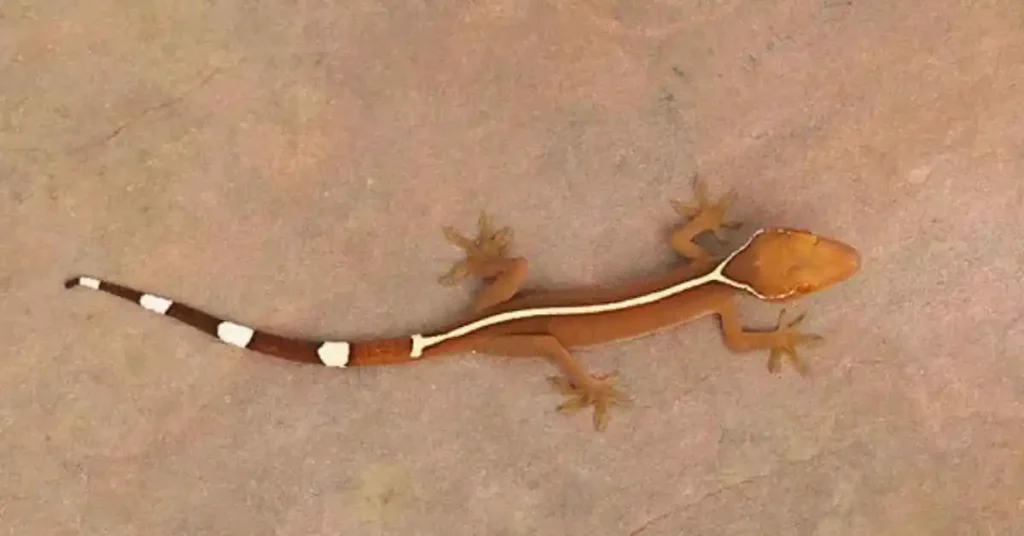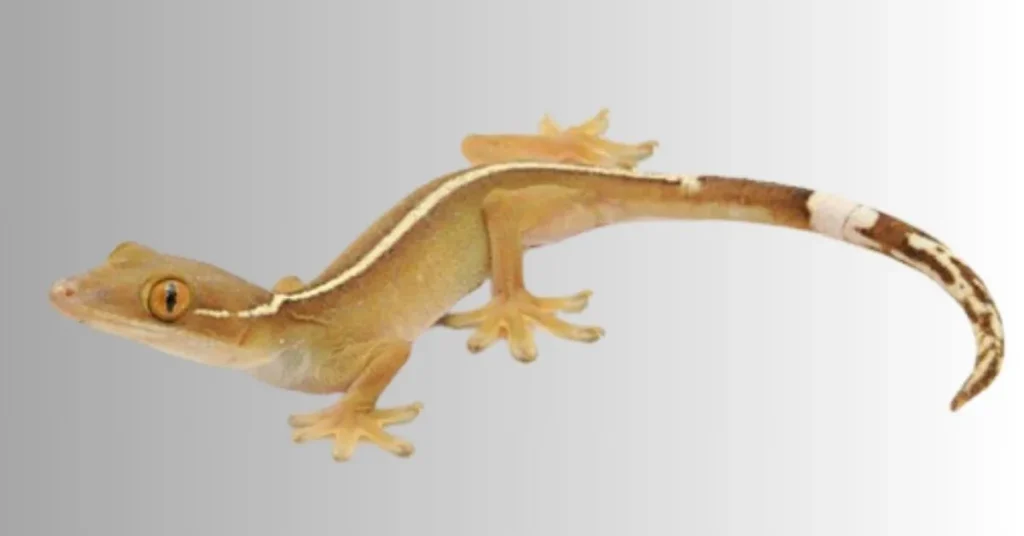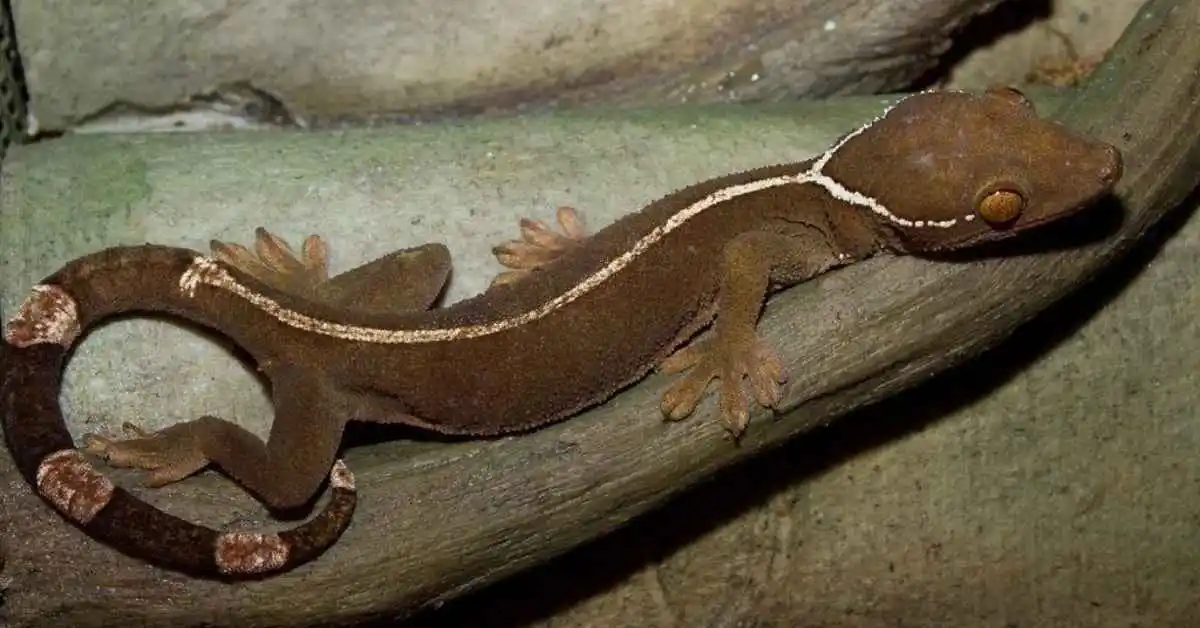White-Lined Gecko
There is a white-lined gecko. Also known as gecko vittatus, this is a small and active gecko. This lizard got its name because of the white stripe on its body, which is from its head to its stomach. They are found mostly in the forests of Southeast Asia. These Geckos come out at night. They are seven to nine inches in size and like to climb. The people keeping them should take care to give them an environment with proper humidity and temperature.
Physical Description:
The white-lined gecko is medium-sized, about 7 to 9 inches long, including its tail. Its head and body are brown. It has a prominent white patch from its nose above its eyes and down its body. Its belly is usually light in color, like cream or white. Its large eyes help it to see well during the night. Pads on the bottom of its feet help it stick to mirrors and walls. Its slender body and long tail usually grow back if broken.

Habitat and Range:
This white-lined gecko lives in tropical rainforests, where it can be found on trees, rocks, and buildings. It prefers warm environments and often lives near rivers or streams. This gecko lives near Southeast Asia, including countries such as Thailand, Indonesia, and Malaysia. They are active at night. They hide in cool shady places during the day. White-lined geckos are good climbers and often live in areas with lots of vegetation and moisture. They are also used to living near people, especially in villages or gardens.
Behaviour:
The white-line geckos are mostly nocturnal, meaning they search for food and roam after dark. During the day it hides in sheltered cool places such as under leaves or in crevices. This gecko is a good climber, using its toe pads to climb walls, roofs, and trees easily. This gecko is shy and avoids people, but if they feel threatened, they can be dangerous, sometimes they make loud barking sounds. They can also drop their tails to avoid predators, especially males, and defend their territory from other geckos.
Breeding Process:
This white-lined gecko reproduces by laying eggs. The female usually lays one or two eggs at a time, hiding them under leaves or in a safe place. It lays eggs a few times a year, especially in warm conditions. Her eggs are hard, she lays her eggs in the place where the eggs stick. Its eggs take 60 to 90 days to hatch, depending on temperature. Its young, called hatchlings, are free from birth and begin foraging as soon as they are born. Parents do not take care of them.
Housing For Day Gecko:
Enclosure:
A white-lined gecko needs a high wall to climb on. A glass tank would be perfect for keeping it. Plants should be planted inside it to make it feel good. A cold zone and a hot zone should be created in it. Moisture should be maintained in the living area of the adhesive, and the walls regularly. Plant it to protect it and create a hiding place using decorations. A water dish should also be inside for drinking water and humidity.
Substrate:
A white-lined gecko litter helps retain moisture and keep the lizard safe. Coconut fibers from orchid bark or a mixture of clay and moss retain moisture and are natural. Keep sand and gravel away from geckos as they can ingest it which can be harmful to them. Adding leaf litter or small plants can make a wall feel more natural. The gecko’s habitat should be kept clean. Special care should be taken to keep it clean and artificial plants should be planted in its box so that the geckos feel good.
Humidity:
Moisture is essential for geckos to stay healthy. One or two or more times a day we have to water his living space to see how fast it dries. It is best to plant live plants to retain moisture. Living plants can help keep the air moist. The humidity of the gecko’s living space should not be reduced, try to maintain the humidity of its space.
Heating and Temperature:
White-lined geckos need warmth to stay healthy, so the temperature of their habitat should be maintained so that it doesn’t harm the geckos. Mats or heat lamps should be used to maintain warmth. Two areas should be created in its living space, one cold and one warm, where the gecko can live easily if it wants to. This method is comfortable for geckos. Check the temperature regularly to ensure that the temperature is just right, neither too high nor too low.
UVB Light:
White-lined geckos do not need UVB light like other reptiles, so if we give them UVB light it will be beneficial for them because they are mostly nocturnal. UVB can be healthy for them, so try to get a few hours of UVB light a day if possible. Geckos can easily avoid this light if they want to.UVB lighting can help prevent health problems and weakened bones.
Water:
White-lined geckos need a lot of water to stay healthy. Always make sure to have a water dish inside their living space. They also drink water droplets from leaves or walls when dusty. Thoroughly mist his living space once or twice a day to provide additional drinking options to maintain humidity levels. Gecko’s water dish should be filled daily to prevent various diseases.
Food and Diet:
White-lined geckos mainly eat insects. You can feed them crickets, small roaches, and mealworms. It should also be noted that the insects should be healthy. To keep a chipmunk healthy, its diet must be good. Give him calcium and vitamins two to three times a week. Feed calcium and vitamins three to four times a week and keep their living space well-cleaned; no baby food should be kept inside.
Lifespan:
In Captivity:
White-lined geckos are easier to care for than other geckos, they only need a wall that is tall. Their living space should have high humidity. It should have a warm living space. Its food is insects. Make the environment look natural and it should also provide a hiding place with climbing structures and decorations. Hold them at least in your hand so that it can grow quickly. Take proper care of them. With good care, they can live for 8 to 10 years.
In the Wild:
If these geckos live in the natural environment, their life span is about five to ten years because there is no proper treatment for them, sometimes they fall victim to predators and sometimes they do not get good food and it is due to hunger. It also dies from the cause.
Price and Cost:
A white-lined gecko usually costs between $20 and $50.The total cost can range from $150 to $300, including living space maintenance, heating, and other expenses. Maintenance costs 10$ to 20$ per month. Factors such as the age and health of the gecko can affect the price. Good lizard care can also cost health.

White-Lined Gecko as Pets:
White-lined geckos make good pets. They are shy, come out at night, and are reptiles. They are also very easy to care for. They need a large wall with good humidity, suitable temperature, and climbing. They feed on insects and can live up to eight to ten years if well cared for, making them ideal for reptile breeders.
Conclusion:
White-lined geckos are interesting low-maintenance pets. These can be good for people who are fond of reptiles. They are easy to care for as long as they are well cared for, meaning they have the right temperature, humidity, and climbing space on their wall. These geckos are shy and can grow up quickly and live healthy lives if well cared for.
FAQs:







